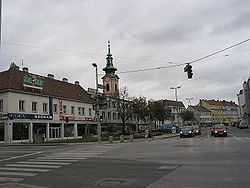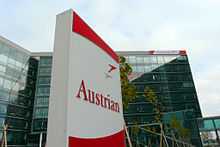Schwechat
| Schwechat | ||
|---|---|---|
 | ||
| ||
 Schwechat | ||
| Coordinates: 48°08′28″N 16°28′43″E / 48.14111°N 16.47861°ECoordinates: 48°08′28″N 16°28′43″E / 48.14111°N 16.47861°E | ||
| Country | Austria | |
| State | Lower Austria | |
| District | Wien-Umgebung | |
| Government | ||
| • Mayor | Hannes Fazekas (SPÖ) | |
| Area | ||
| • Total | 44.7 km2 (17.3 sq mi) | |
| Elevation | 162 m (531 ft) | |
| Population (1 January 2013)[1] | ||
| • Total | 16,805 | |
| • Density | 380/km2 (970/sq mi) | |
| Time zone | CET (UTC+1) | |
| • Summer (DST) | CEST (UTC+2) | |
| Postal code | 2320 | |
| Area code | 01 | |
| Vehicle registration | SW | |
| Website | www.schwechat.gv.at | |
Schwechat (German pronunciation: [ˈʃvɛçaːt]) is a town southeast of Vienna known for the Vienna International Airport and Schwechater beer. The city is home to the refineries of to the Austrian national oil company OMV.
Geography
Schwechat is named after the river Schwechat, which flows through the center of town. The city subdivisions called Katastralgemeinde (Cadastre) are Kledering, Mannswörth, Rannersdorf and Schwechat.
Population
| Historical population | ||
|---|---|---|
| Year | Pop. | ±% |
| 1869 | 7,458 | — |
| 1880 | 8,910 | +19.5% |
| 1890 | 10,327 | +15.9% |
| 1900 | 13,636 | +32.0% |
| 1910 | 14,625 | +7.3% |
| 1923 | 14,372 | −1.7% |
| 1934 | 14,936 | +3.9% |
| 1939 | 14,813 | −0.8% |
| 1951 | 13,270 | −10.4% |
| 1961 | 13,403 | +1.0% |
| 1971 | 15,303 | +14.2% |
| 1981 | 14,834 | −3.1% |
| 1991 | 14,669 | −1.1% |
| 2001 | 15,286 | +4.2% |
| 2011 | 16,329 | +6.8% |
History
Home to the settlement Ala Nova of the Roman Empire, the city was first mentioned in a document in 1334.[citation needed] The meeting at Schwechat of Emperor Leopold I with Jan Sobieski in 1683, after the liberation of Vienna, is commemorated by an obelisk. The imperial troops defeated the Hungarian insurgents in a battle fought here in October 1848.[2]
In 1724, a textile factory was established in Schwechat. Schwechat profited massively from the Austrian industrialisation wave of the 19th century, many of the companies established then still existing today (like the brewery). Schwechat became a city in 1924 and was incorporated into Vienna in 1938. The city's oil refinery was a bombing target of the Allied Oil Campaign of World War II, with the southern aviation plant complex of the Heinkel firm also targeted in late 1943 and lasting through the spring of 1944.
Schwechat became an independent city in 1954.
Economy

Vienna International Airport, the headquarters of Austrian Airlines, and the headquarters of Niki are in the city of Schwechat.[3][4][5] When Lauda Air was an independent airline, it had its corporate headquarters in Schwechat.[6]
References
- ↑ Statistik Austria - Bevölkerung zu Jahres- und Quartalsanfang, 2013-01-01.
- ↑
 One or more of the preceding sentences incorporates text from a publication now in the public domain: Chisholm, Hugh, ed. (1911). "Schwechat". Encyclopædia Britannica 24 (11th ed.). Cambridge University Press. p. 391
One or more of the preceding sentences incorporates text from a publication now in the public domain: Chisholm, Hugh, ed. (1911). "Schwechat". Encyclopædia Britannica 24 (11th ed.). Cambridge University Press. p. 391 - ↑ "Offices in Austria". Austrian Airlines. Retrieved 26 May 2009.
- ↑ "About Us Contact". Niki. Retrieved 2 September 2009.
- ↑ "Information about the city plan." City of Schwechat. Retrieved on 5 September 2009.
- ↑ "World Airline Directory". Flight International. 27 March-2 April 1991. Retrieved 3 February 2013.
External links
| Wikimedia Commons has media related to Schwechat. |
- Website of Schwechat (German)
| |||||
